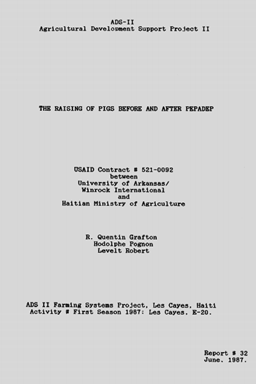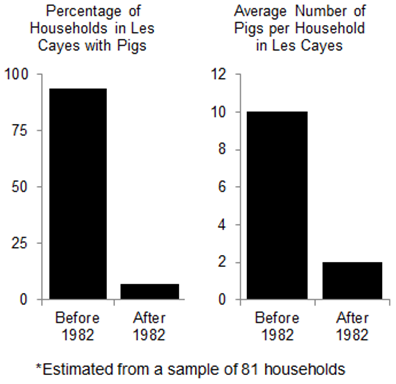"The Haitian Pig Slaughter" by Gerald Murray, Ph.D.
Murray is Professor emeritus of Anthropology at the University of Florida. He has written numerous works on Haitian peasants and the environment.
Throughout rural Haiti the hardy Creole pig, capable of scavenging and surviving, became a major weapon in the economic survival strategy of the peasant household. A heavy percentage of crops are traditionally sold.
Some of the money is spent immediately, but much is saved for a rainy day-- sickness, funeral expenses, weddings, etc. And a major traditional goal was the accumulation of cash to permit the purchase of more land if and when it suddenly became available. But you don’t keep cash under the sleeping mat. The pig served as a bank in that regard. Few pigs were raised for home consumption, except on certain ritual occasions. Most pigs were raised as a source of savings that could easily be mobilized when the needs arose. As the agrarian economy declined, two things happened to the pig. First its relative economic importance increased. With deforestation, soil erosion, and decreased rainfall, the risk of agricultural failure increased. The relative dependence of the rural household on income from its livestock increased. Secondly, the sale of pigs was used increasingly as a vehicle for liberating one’s children by sending them to school in hopes that they would qualify for urban employment.
By the late 1970s it was estimated that there may have been 1.2 million pigs in Haiti. But then catastrophe struck in the form of African Swine Flu (ASF) which first made its way into Haiti in 1978 from the neighboring Dominican Republic. Large numbers of pigs died. In 1981 a powerful consortium of foreign institutions (FAO, OAS, IDB, and three governments, including that of the U.S.) convinced the Haitian government (1) to kill all pigs in Haiti, (2) to compensate farmers, and (3) to supply new pigs. The first happened completely; quite predictably, two and three happened only sporadically.
Some claim that the epidemic was bogus and the slaughter was unnecessary. That is questionable; whereas 400,000 pigs were killed, as many as 600,000 may have died of ASF. Two things, however, are unquestionable. (1) The foreign swine carefully selected as replacements were of diversified and high quality genetic stock. But with their requirements of special pens, commercially purchased feed, and regular veterinary services, they were poorly adapted to the economic conditions prevailing in rural Haiti. As one farmer complained: "The foreign pig lives in a better house and eats better food than we do." (2) Though the pigs were killed, neither the compensation nor the swine repopulation happened as planned and promised. USAID money was managed by IICA, a branch of the OAS. Serious attempts were made to ensure equitable distribution. But it was easier to kill peasant pigs than to program equitable distribution of follow-on resources. Elites ended up benefiting. Welcome to Haiti.
In the pig slaughter of 1981, $100 million was at stake. Thirty years later, in post-earthquake Haiti, the dilemma of dysfunctional and predatory institutions persists. Now the big league predators are foreign NGOs, not the Haitian government. And now there are billions waiting to be invested. Or diverted.

